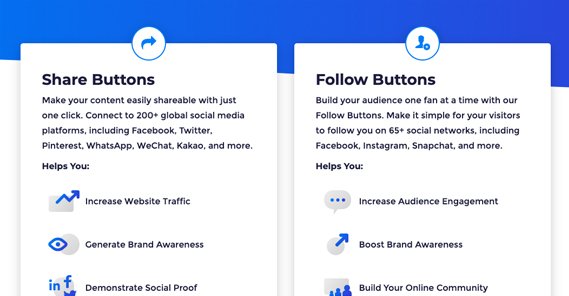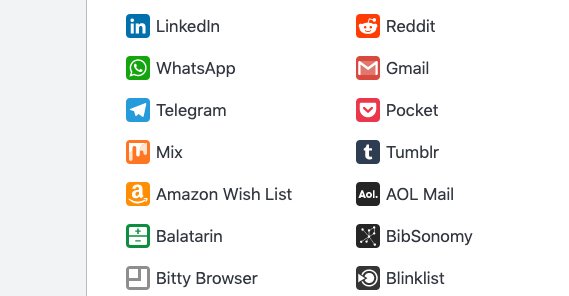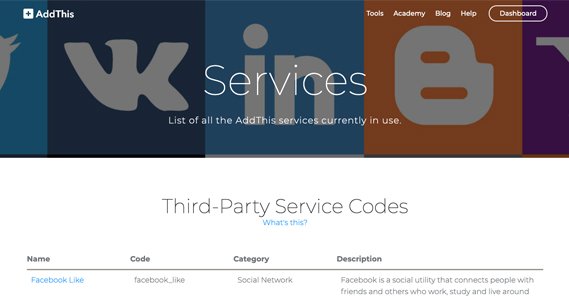AddToAny vs AddThis vs ShareThis: What is The Best Plugin?
Published by Drew Hendricks • Resources • Posted November 3, 2019 ContentPowered.com
ContentPowered.com
In the world of social sharing buttons, there are dozens of different plugins out there, if not hundreds of viable options. I personally tend to prefer the big guns of Social Warfare, but I acknowledge that they aren’t ideal for everyone. As such, I’ve decided to review and compare three of the most popular social sharing suites: AddToAny, AddThis, and ShareThis.
Where to Find Them
First, so you can follow along or so you can grab the buttons yourself, here’s where you can find each of the three products I’m comparing.
Compatibility
Next up, let’s look at the compatibility for each.
AddToAny – Sharing buttons from AddToAny are available for basically any platform. They have a page with each option. Clicking on an option will take you to instructions for installing the buttons on that platform. Supported platforms include WordPress via a plugin, Drupal, Joomla, WordPress.com sites, Cloudflare, Tumblr, Blogger, TypePad, FeedFlare, and Elgg. They also have an option for embedding buttons in your email signature, and a generic code package for use on a custom website.
AddThis – In order to get the code for this social sharing suite, you need to register an account. Once in, they give you the option to install on sites with a variety of different platforms. These include WordPress, AMP pages, generic HTML websites, Shopify pages, Blogger pages, SquareSpace pages, Magento, Wix, Weebly, and other website builders and blogging platforms.
ShareThis – Clicking to get the buttons brings you to a page to choose a style, whereupon you can then choose a platform. Supported platforms include Weebly, Jimdo, BigCommerce, Shopify, WordPress, Wix, SquareSpace, and a generic HTML code package to install on another form of website.
Pricing
If you’re looking at plugins like these, you’re probably concerned about pricing. Do any of these three options have specific pricing requirements, restrictions, or other caveats? Let’s look.
AddToAny – This set of sharing buttons is free to get and install, and has no paid plans at all.
AddThis – This set of sharing buttons is free to obtain and use, and includes all of their additional features. However, they also have an enterprise version. The enterprise version allows you to get priority support, white glove service, and custom design for your buttons. I have no idea what the pricing is, because I’ve never needed any of those features. You can contact them yourself if you’re curious.
ShareThis – This set of sharing buttons is free to get and install, and has no paid plans at all.
Supported Social Networks
One of the main features of a social sharing button suite is the set of social networks it covers. If you have a specific network you need covered and they don’t cover it, you either have to edit the code to include it yourself, or find a different option. I know which one I’d usually choose. So which networks do these tools cover?
AddToAny – When you choose to get the code for this plugin, you choose which networks to include and what order to include them.
They have a lot of networks in their list. Here’s the full list as of this writing:
Facebook, Twitter, Email, Pinterest, LinkedIn, Reddit, WhatsApp, Gmail, Telegram, Pocket, Mix, Tumblr, Amazon Wishlist, AOL Mail, Balatarin, Bibsonomy, Bitty Browser, Blinklist, Blogger, BlogMarks, Bookmarks.fr, Box.net, Buffer, Care2 News, CiteULike, Copy Link, Design Float, Diary.ru, Diaspora, Digg, Diigo, Douban, Draugiem, DZone, Evernote, Facebook Messenger, Fark, Flipboard, Folkd, Google Bookmarks, Google Classroom, Hacker News, Hatena, Houzz, Instapaper, Kakao, Kik, Kindle It, Known, Line, LiveJournal, Mail.ru, Mastodon, Mendeley, Meneame, MeWe, Mixi, MySpace, Netvouz, Odnoklassniki, Outlook.com, Papaly, Pinboard, Plurk, Print, PrintFriendly, Protopage, Pusha, QZone, Rediff MyPage, Refind, Renren, Sina Weibo, SiteJot, Skype, Slashdot, SMS, StockTwits, Svejo, Symbaloo, Threema, Trello, Tuenti, Twiddla, TypePad, Viadeo, Viber, VK, Wanelo, WeChat, WordPress, Wykop, Xing, Yahoo Mail, Yoolink, and Yummly.
If you’ve never heard of most of these, don’t worry; I haven’t either. A lot of them are email clients, messenger apps, or foreign language social networks based in eastern Europe or Asia.
AddThis – If you thought the list above was a lot, get read for… I’m just kidding. I’m not going to type out everything AddThis supports, because they did it for me. Just take a look at this page.
The trick is that AddThis doesn’t support these natively; you have to manually add them, which is why they give you the specific code used to activate it. There’s a huge number of sites there, some of which aren’t even social sites, but they still might have a niche role for your website.
ShareThis – This service has a more traditional array of social networks available to choose from. The full list is: Facebook, Twitter, Pinterest, Email, SMS, Facebook Messenger, ShareThis itself, LinkedIn, Reddit, Tumblr, Digg, StumbleUpon (now defunct), WhatsApp, VK, Weibo, Odnoklassniki, Xing, Print, Blogger, Flipboard, Meneame, Mail.ru, Delicious, Buffer, Diaspora, Douban, Evernote, Google Bookmarks, Gmail, Hacker News, Instapaper, Line, Pocket, QZone, Refind, RenRen, SurfingBird, Skype, Telegram, Threema, Yahoo, WordPress, and WeChat.
Features
The features comparison is probably the most important, and will take up the bulk of this article. Let’s dig in.
AddToAny – This service has your basic social sharing buttons, as you might expect. It also has floating share buttons and a couple of other configuration options. You can upload your own SVG icons to use in place of the default icons, if you wish. AddToAny is also mobile responsive out of the box. It does not have it’s own analytics, but it allows you to tie into Google Analytics out of the box as well.
Perhaps the biggest benefit of AddToAny is that it is basically open source. Their FAQ and Customize menus give you tips on how to do anything from how to change the button alignment to how to modify event handling and implement asynchronous loading. If you’re willing to make some modifications, you can completely customize this platform to suit your needs.
AddToAny also has browser extensions that you can install to give yourself customized social sharing tools on any website you visit. These aren’t really useful from a business perspective, but users may like them.
AddThis – AddThis has several different kinds of sharing buttons, including floating buttons, inline buttons, expanding buttons, image sharing pops, pop-overs, banners, and sliders. However, they also have several other tools as part of their overall package.
- Follow buttons, distinct from sharing buttons, that allow a user to follow your page with a click. Since getting users to follow an account is generally more valuable than just getting them to share a single post, this can be a useful tool.
- Link promotion plugins, like a Hello Bar style banner or a mobile ad-like pop-over. These banners can be used to promote specific links, deals, or other content you really want your users to see no matter where they visit on your site.
- List building tools, like an exit intent pop or time-delayed pop-over script. As a user of exit intent pop-overs, as annoying as they can be sometimes, they’re very effective at getting people to sign up, assuming you have the right offer.
- Additional website tools, like a related posts widget for your blog posts. You can get more advanced versions of these tools from other sources, but then you’re going to be managing five different plugins instead of just one, and that might not be what you want to do.
Additionally, AddThis boasts that they are the only social sharing plugin that is available as a component for Google’s AMP initiative. If you don’t know what this means, it’s basically meaningless. If you’re invested in AMP pages, this can be a huge benefit.
ShareThis – This social sharing plugin is basically just that; a dedicated sharing plugin. It’s lightly customizable, and mobile optimized. It has support for ten different languages. Those languages are English, German, Spanish, French, Italian, Japanese, Korean, Portuguese, Russian, and Chinese.
Like AddThis, ShareThis also has a couple of extra tools you can use. There’s the share buttons, but also follow buttons, which do what they say on the tin; allow your users to click them to follow your account on social media. You do, of course, have to actually have an account or page for them to follow, so this takes slightly more configuration than sharing buttons do.
They also have a reactions button. This is basically a custom toolbar that works similar to how Facebook’s like/reactions work. They are, in fact, the same set of reactions out of the box. You have the like, love, laugh, shock, cry, and anger emojis, and you can choose to remove some if you only want a few of them. Customization isn’t very robust for them, but it’s more of a gimmick toolbar than a useful marketing tool, I feel.
ShareThis is the only platform out of the three to provide pages directly comparing themselves (favorably, of course) to other tools. For example, on their page comparing themselves to AddThis, they claim to have everything AddThis does, plus social split testing, GDPR compliance, and independent operation.
Final Verdict
The tool suite you choose depends on your needs. If you need certain social networks that aren’t commonly available, you need to find the tool that supports it. In general, this is going to be AddThis, though you will need to make manual edits to make it work. This shouldn’t be too difficult, though.
Additionally, if you want extra features or display modes, AddThis is probably your most robust option. That is, if you want an all-in-one solution. If you’re not worried about having control over all of those plugins in one place – or if you want individual plugins like YARRP or Hello Bar with their more advanced features – you can get those instead. AddThis is only useful in this respect if you want something that does everything decently, but nothing exceptionally.
Conversely, if you want a simple setup and install process with minimal options or configuration, ShareThis is your best choice.
I like that AddToAny is basically just open source and completely customizable to your needs. They’ll help you out if you want to make advanced tweaks to the platform, and indeed give you a lot of tips from their customization menu on how to do it, depending on the platform you’re using.
At the same time, I’m less of a fan of the fact that AddThis requires you to log in to use their tools. Rather than managing your plugins directly from your own space, you have to go through their dashboard to do it. Even though it’s free, it’s an extra bump in the road.
I should also note that in some third party testing, AddThis showed some inaccuracies with their share counts and does a lot of third party cookie tracking and other referrals. I don’t know how much it has improved in the last few years, but given that it centralizes everything in its own dashboard, I assume not a lot.
If you would like to weigh in on this discussion, comment below. I’m curious what my readers have been using. What do you use on your website, and how has it worked for you? Have you had any issues with one of these three plugins? Do you have an alternative you prefer over these three? Tell us your story.












